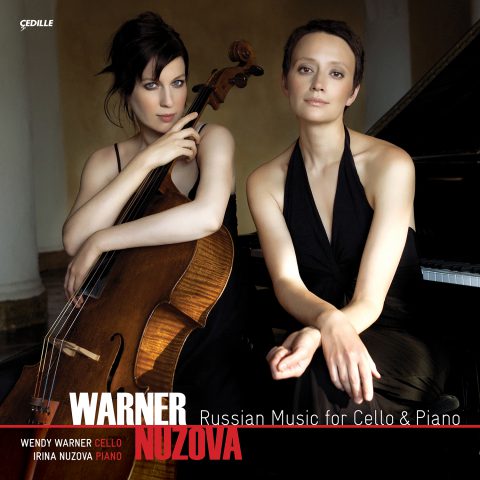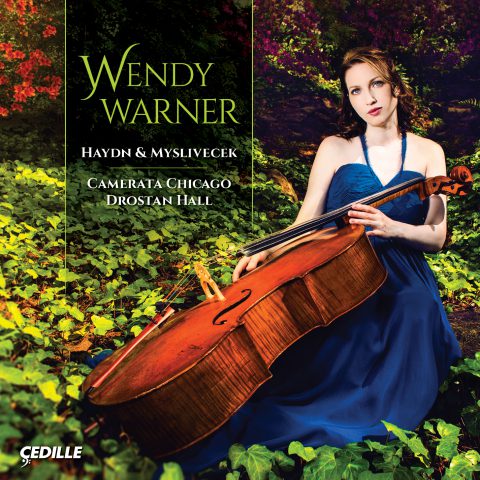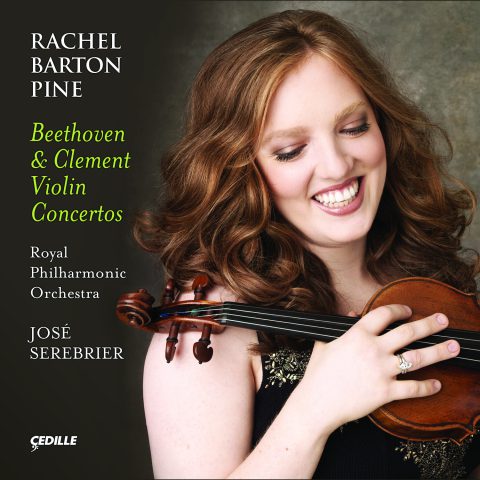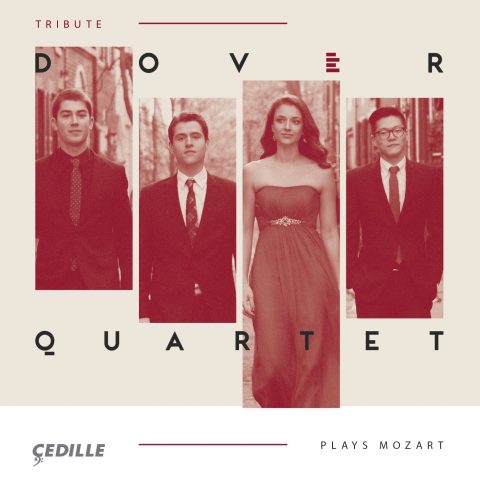Store
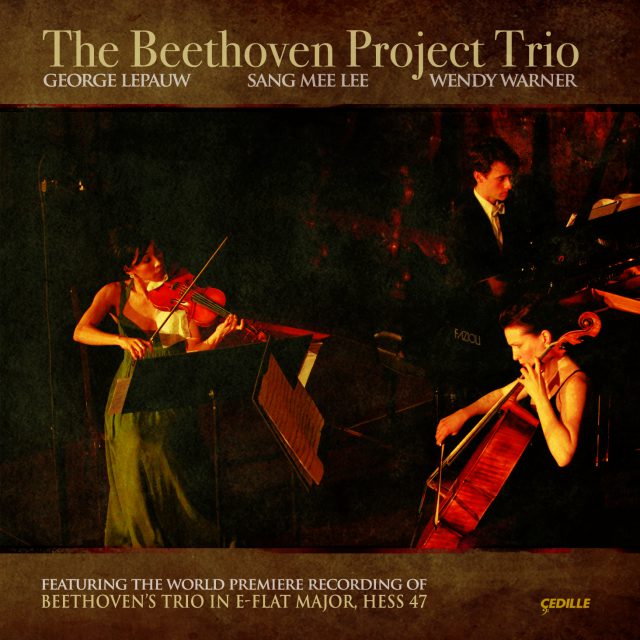
The recently launched Beethoven Project Trio makes its CD debut with the world premiere recording of Beethoven’s recently rediscovered Piano Trio in E-Flat Major, Hess 47, plus two more rarely-heard Beethoven piano trios.
The ensemble: pianist George Lepauw, violinist Sang Mee Lee, and cellist Wendy Warner — all internationally known soloists — gave the world premiere performance of the “Hess 47” piano trio on March 1, 2009, in a Chicago concert that received worldwide attention.
The piece is an original reworking, by Beethoven himself, of his String Trio, Op. 3, though he finished only the first movement. In a concert review, Chicago Tribune critic John von Rhein wrote that the work “casts revealing light on the master’s working methods. . . . The piano part abounds in forte and piano contrasts that lend surprise and color.”
Also on the new CD is a pair of Beethoven piano trios that received their American premieres at the same 2009 concert. The passionate and dramatic Piano Trio in E-Flat Major, Op. 63, which Beethoven based on his String Quintet, Op. 4 and Wind Octet, Op. 103 (an early work despite the late opus number). His early Piano Trio in D Major, Kinsky/Halm Anhang 3, was long mistaken as a work of Mozart’s because of its lyrical charm.
The Chicago Tribune praised the Beethoven Project Trio as a “splendid ensemble, playing with finely judged balance, evenness of sound and unanimity of style.”
Producer for this landmark studio recording is Max Wilcox, famed for his work on pianist Arthur Rubinstein’s RCA recordings, as well as projects with the Guarneri Quartet, Van Cliburn, Itzhak Perlman, and Eugene Ormandy and the Philadelphia Orchestra.
Preview Excerpts
Piano Trio in E-Flat Major, Hess 47
Piano Trio in D Major, Kinsky/Halm Anhang 3
Piano Trio in E Flat Major, Opus 63
Artists
1: WORLD PREMIERE RECORDING
Program Notes
Download Album BookletThe Trios
Notes by James F. Green
Trio for Piano, Violin and Cello in E-Flat Major, Hess 47
A World Premiere Recording
This piece is an original arrangement by Beethoven himself, from his String Trio Opus 3, originally in six movements, composed in 1794. The original Opus 3 was Beethoven’s first composition for violin, viola and cello, for which group of instruments he wrote only four more pieces: the Serenade Opus 8, and the three trios Opus 9, in 1797-98. Unfortunately, he only completed the first movement in his arrangement for piano trio, and no exact date has been given for that work, except that it was certainly not done before 1800. That alone, however, is a clue that Beethoven not only liked his string trio enough to use it again in a different form, but that at a different period of his life, with added maturity, he chose to use the same material to create a new piece. Although the two pieces are, note wise, nearly identical twins, their musical personalities are very different, as the inclusion of the piano gives the same music much more dramatic energy.
The string trio, with its six movements, most resembles the serenade or divertimento form, which was still popular at the end of the 18th century. These works were often intended for outdoor performance and always light in nature. Although the Opus 3 is unmistakable Beethoven, it does have many similarities with Mozart’s string trio Divertimento, published in 1792 (K563): it shares the same key of E-flat and has the same number of movements. The opening of Beethoven’s Opus 3 has a full, almost orchestral sound, and the Piano Trio version, Hess 47, amplifies that effect. The whole movement is full of vibrant energy, optimistic in nature, despite a very interesting “false recapitulation” in f minor that gives the piece a sudden, but fleeting, darkness. The constant syncopations give it a sense of breathless pursuit, and a wonderfully youthful spirit. The development section is unusually extensive for this period of Beethoven’s writing, something he did not repeat until his Opus 18 string quartets.
The first edition of the piano trio version was published by Wilhelm Altmann in the Zeitschrift für Musikwissenschaft, a scholarly journal, in 1920. The autograph eventually came into the possession of the great collector Dr. Hans-Carl Bodmer of Zürich, who collected innumerable objects, manuscripts, and letters of Beethoven before donating everything to the Beethoven-Haus in Bonn upon his death in 1956 (incidentally, Dr. Bodmer was also a great friend and patron of the famous German-Swiss author Hermann Hesse). The important 20th century Beethoven scholar, Willy Hess gave it number 47 in his catalogue of Beethoven’s lost and forgotten works.
That it had never been performed publicly before March 1, 2009 — in Chicago by the Beethoven Project Trio — nor recorded until now is mysterious, though probably more a sign of the human capacity for oversight than anything else. Individual parts were not included in either the work’s original 1920 publication or in its mid-century printing in Breitkopf & Härtel’s complete Beethoven works, making performance impractical. To this day, no performance edition has been published; it took several days and nights of manually copying, cutting, taping, and copying again for the Beethoven Project Trio to have useable parts for the World Premiere performance (and even then the scores were unwieldy and oversized).
The International Beethoven Project is currently working on a performance edition of this work and the other two trios (including commentary by the members of the Beethoven Project Trio), scheduled to be published before the end of 2010.
Trio for Piano, Violin and Violoncello in D Major, Kinsky/Halm Anhang 3
An American Premiere, edited and arranged by Robert McConnell
This work is an original piano trio by Beethoven, dated 1799, although we have no information on the work’s genesis. It is in two movements, the first an Allegro in sonata form, the second a Rondo Allegretto in the style of a German folk dance.
The first movement, from the very opening to the end, is reminiscent of a Haydn symphony. It is highly classical in form, without a real development but rather a long recapitulation of the opening thematic material in A Major that eventually lands back in the home key of D Major before coming to a close. The whole movement is full of vivacity, some virtuosity in the piano part, and a great deal of charm. The second movement begins with an eight-bar introduction of the theme in the piano part alone. The melody is lilting, in a naïve folk-style with a certain pastoral charm, and the whole is characterized by suspensions in harmony and time, that resume in joyous musical frolicking. A couple of passages in b minor and f minor, the last a particularly bold choice, come through to give the piece more depth. Eventually, a modulation into F Major and then d minor leads back to the original D Major tonality to close the piece cheerfully.
The work’s manuscript survives in an autograph preserved at the British Library in London. Two pages of the manuscript are missing in the first movement, which is the principal problem with this piece. We know the autograph was prepared for publication because the bars were numbered, a common practice on clean copies intended for delivery to a publisher. The numbering tells us exactly thirty-three bars are missing from the first movement, from bar 63 until bar 96. This is what made it possible for Robert McConnell to reconstruct the missing segment for the performance and recording. In Mr. McConnell’s words:
The piece does not have a real development section (sort of like the Marriage of Figaro overture), and I believe that the music basically repeats itself in A major (slightly truncated) with the final move to D major only occurring in measure 108. Here is why I think so: after the 33 measures’ gap, the music returns in bar 96, which corresponds to measure 36 of the exposition. Bar 96, however, is on a dominant seventh chord on B which implies a move to E Major, and indeed, the music comes to a full cadence on E in bar 106 (corresponding to bar 46 in the exposition). If the piece had previously returned to D major, as we would usually expect in a recapitulation, this harmonic move would make no sense, but here it works if the music just repeats itself transposed into A. Furthermore, 33 measures does not leave any time for a development, only a final cadence in A to round out the exposition, and a truncated recapitulation.
Curiously, the piece was originally thought to be a work of Mozart’s and was catalogued by Ludwig Ritter von Köchel as Anhang 52a in his Mozart catalogue, thus making it the only Beethoven work to have a Köchel number! By the early 20th century, however, scholars were changing their minds and it was published by Georges de Sainte-Foix as a work of Beethoven’s in “Oeuvres inédites de Beethoven,” Vol. 2 of the Publications de la Société française de Musicologie, Paris, E. Droz, in 1926. In 1962, Jack Werner published an edition, listing it as Beethoven’s Rondo in D. Trio for Violin, Cello and Pianoforte, Chappell, London. One reason authentication proved so difficult for so long is that the handwriting is not Beethoven’s but that of Kaspar Karl van Beethoven, one of the composer’s brothers: in his early years in Vienna, Kaspar Karl acted as a copyist and business manager for his older brother, which helps to explain some of the confusion over this piece.
Trio for Piano, Violin and Violoncello, in E-Flat major, Opus 63
An American Premiere
This work was published in July 1806 by Artaria & Co. in Vienna as: “GRANDE SONATE / pour le Forte-Piano / avec Violon et Basse obligée / tirée du Grand Quintetto Op. 4. / composée / par / LOUIS van BEETHOVEN.” Scholars throughout the 19th and most of the 20th century have been divided over the authenticity of this piece, some asserting that Beethoven had nothing to do with this transcription from his String Quintet Opus 4 of 1795. Yet the 1806 as well as the 1818 Artaria editions clearly identify Beethoven as the composer of this trio. Ardent Beethoven admirer, Franz Liszt’s own complete edition of Beethoven’s works, published in 1859 by L. Holle, not only includes Opus 63, but lists it as an “arrangement from the String Quintet Opus 4 by the composer” (emphasis mine). The work was also listed as wholly by Beethoven in the ground-breaking encyclopedia of music by François-Joseph Fétis, in Histoire universelle de musique (Paris, 1869–1876). It was, however, left out of other editions thereafter, from the Alte Gesamptausgabe (Complete Edition) by Breitkopf & Härtel in the 1860s up through the Neue Gesamptausgabe of G. Henle in the 1970s.
Most scholars today, however, armed with greater details surrounding its publication and a closer examination of the facts, have come to a convincing conclusion. Primary among these facts stands Artaria’s up-to-date catalogue of Beethoven’s complete works from 1819, which Beethoven himself approved, opus 63 included. Beethoven was extremely protective of anything published with his name on it: it was not uncommon at the time for publishers to have a work by a famous composer arranged for another set of instruments without obtaining the author’s permission, and without clearly stating that the arrangement was by someone other than the composer himself. When this sort of situation came up, Beethoven would always show his displeasure by writing a letter to the guilty publisher demanding that the name of the arranger be clearly printed on the front page, so no one would think it was an original composition. That Beethoven never wrote such a letter to his Viennese publisher, Carlo Artaria, or to anybody else about this is strong evidence that he took full credit for this piano trio arrangement. Artaria even published a second edition in 1818, which would have been yet another opportunity for Beethoven to make a case against the publisher had this not been his own work (Beethoven and Artaria actually went to court over a copyright issue in 1803.)
The origins of this piece are slightly byzantine. Beethoven first wrote a version for wind octet that was published (with some later revisions) as opus 103, in 1830 (three years after Beethoven’s death). Written as dinner music for the Archbishop of Bonn right before Beethoven’s move to Vienna, it actually dates from 1792. It is steeped in Beethoven’s compositional style from his last years in Bonn, when he first began to write a great deal of music, mostly for occasions at the court of the Elector where he was employed, or for Summer parties on estates along the Rhein, where he often performed. It also reflects the background and divertimento nature of much of the non-vocal music still being written at the time, before concert halls had emerged. In many ways, this wind octet is a study for Beethoven’s use of wind instruments in symphonies later on. In true Beethoven fashion, the writing was not easy for wind players of the time.
The String Quintet Opus 4 is itself an arrangement from the work’s earliest version as a wind octet. Beethoven made many changes from the octet to the quintet, not only to account for the completely new instrumentation and timbre, but also imparting a new conception of balance and form. Although the two pieces would be recognized as very similar, the composer made many changes that affect the whole, including moving around some themes and outright changes in notes and voicing. Among the more obvious alterations are the additions of a second trio in the Scherzo and a secondary theme in the Finale. Taken as a whole, the quintet is more cohesive, mature, and reflective of Beethoven’s progress as a composer over the nearly four years between the two versions, the quintet being completed late in 1795 and published the next year by Artaria.
The version recorded here, for piano trio, listed as Opus 63, is more closely related to the quintet. Although there is no precise indication of when Beethoven reworked his Opus 4 into this piano trio, the publication date of 1806 suggests he worked on it in 1805 or early 1806. The year coincides with Beethoven’s reconciliation with his publisher Artaria, after four years of conflict and litigation relating to what Beethoven considered Artaria’s unauthorized publication of his Opus 29 String Quintet. The court’s final verdict against Beethoven in 1805 required that he compose a new string quintet for Artaria — something Beethoven never actually did. Could it be that he reworked the Opus 4 String Quintet into a piano trio instead? This would have been relatively easy for him, and probably would have satisfied Artaria.
Between 1805 and 1807, Beethoven com composed Fidelio, his Fourth Piano Concerto, the Appassionata Sonata, Razumovsky String Quartets, Fourth Symphony, Violin Concerto, Overture to Coriolan, Sixth (“Pastoral”) Symphony, etc. That he also worked on this piano trio, Opus 63, during this bountiful and inspired period of his life is very revealing. In its piano trio form, this piece that began life 13 or 14 years earlier as a wind octet, gains a far greater level of depth than in either of its previous incarnations. It is notable that with each new version, Beethoven paired down the number of instruments, perhaps seeking greater clarity of line and expression, streamlining the piece to its most basic structure, and making much more out of less.
Like all of Beethoven’s works with piano, it is the instrument at which he gained so much recognition that gets to shine. The piano is primary in this piece, and in many passages speaks as it might in a concerto. It is also clear that this piece was not originally intended as a piano trio, as some parts were more obviously written with a different sound in mind, namely that of wind instruments. The mood overall is sunny, E-flat Major being a very grounded and warm key. Of the four movements, the Andante is perhaps the jewel of the piece with its alluring beauty and charm.
Album Details
Total Time: 59:57
Producer: Max Wilcox
Engineer: Joe Patrych, David Merrill, and Jonathan Schultz
Art Direction: Adam Fleishman – www.adamfleishman.com
Cover Photo: John Kringas
Recorded: August 31 – September 4, 2009, at the American Academy of Arts and Letters, New York City
© 2010 Cedille Records/Cedille Chicago
CDR 90000 118
